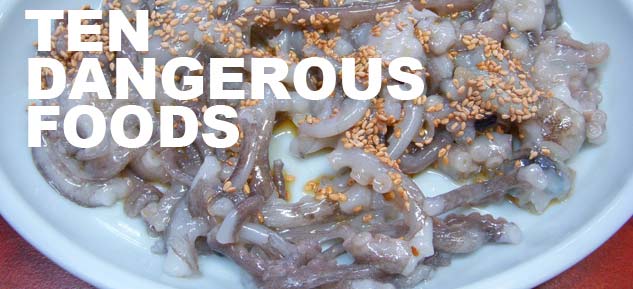Sannakji(Live Octopus)
In Korean Cuisine, Sannakji, is a raw dish which you can eat live. In this there is live octopus, which is chopped up and seasoned while still alive. The only danger in eating is the suction cups, which are still active and can stick to the throat. There is a risk of suffocation.
Fugu Puffer fish(blowfish)
In Japanese cuisine fugu(blowfish), is a real delicacy. It is so poisonous that a little mistake in its preparation could be fatal. Only highly trained and licensed chefs are allowed to serve the dish.
Ackee ( Ackee apple)
In Jamaica, the ackee fruit, is the national fruit. If unripened, improperly eaten, ackee fruit can cause Vomiting Sickness which can lead to coma or death.
Cassava
Cassava is eaten widely in Africa and South America – but must be very thoroughly cooked before being eaten. Chew it raw, and an enzyme in the tuber converts into cyanide.
African bullfrog (Pyxicephalus Adspersus)
Those thrill seekers trekking across southern Africa may come across this amphibian on the menu in places like Namibia. But be warned: the African bullfrog contains a variety of substances toxic to humans.
Elderberries
While some varieties are safe to eat, those that aren’t ripe or cooked properly can cause diarrhea and seizures.
Casu Marzu
Sardinians call tradition rotten maggot cheese made from sheep’s-milk. It is laid outside in the open to allow flies to lay eggs inside which then hatch into maggots and feed on the cheese causing fermentation. When eating, wearing eye protection is recommended because the maggots can jump six inches into your eyeballs.
Raw cashews
Raw cashews contain a toxic substance that can be fatal if eaten in large quantities. Raw cashews can cause illness even if you don’t have nuts allergy. The raw cashews in supermarkets have been steamed to remove the dangerous chemical.
Hakarl
Hakari, is a national dish of Iceland consisting of a Greenland shark. It is a worst tasting food on earth. If not well prepared, it is essentially a recipe for food-borne illness.
Blood Cockle
Even if you don’t have a shellfish allergy, blood clams are best avoided. The clams can harbor hepatitis A, typhoid and dysentery because they live in lower-oxygen environments. Blood clams from Chinese waters have been linked to hepatitis outbreaks.

